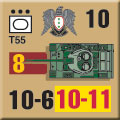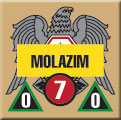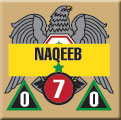| Sword of Israel:
Syrian Pieces, Part Three
By Mike Bennighof, Ph.D.
October 2022
 In Panzer Grenadier (Modern): 1967: Sword of Israel, the Syrian Arab Army has low morale, poor initiative and abysmal leadership. It can stand up to the Israel Defense Forces for two reasons. First, the Golan Heights are a natural fortress, made even more formidable by Soviet-designed fortifications. And second, their Soviet patrons have supplied (not a gift, but at a 33-percent discount) some modern weaponry on par with what the Israelis field: the best tanks the Soviets have to offer (well, the best that they’re willing to export at a discount price) and mobile, armored carriers to bring the infantry to the battlefield. Better artillery and small arms than what the Israelis can offer their troops. They’ve exported everything the Syrians need. Except the will to fight. In Panzer Grenadier (Modern): 1967: Sword of Israel, the Syrian Arab Army has low morale, poor initiative and abysmal leadership. It can stand up to the Israel Defense Forces for two reasons. First, the Golan Heights are a natural fortress, made even more formidable by Soviet-designed fortifications. And second, their Soviet patrons have supplied (not a gift, but at a 33-percent discount) some modern weaponry on par with what the Israelis field: the best tanks the Soviets have to offer (well, the best that they’re willing to export at a discount price) and mobile, armored carriers to bring the infantry to the battlefield. Better artillery and small arms than what the Israelis can offer their troops. They’ve exported everything the Syrians need. Except the will to fight.
Let’s have a look at more of their shiny stuff.
Cutting Edge Armor
 
Following a major arms sale agreement in 1962, in the mid-1960’s the Syrians began to take delivery of what was then the state of the art in Soviet tank design, the T-54 medium tank. Development began during the last year of the Great Patriotic War when it became clear that while the 100mm D10-S gun could easily be adapted as a tank gun. But the suspension of the T-34 could not withstand its powerful recoil.
The T-54 took the “frying pan” turret of the late-war Josef Stalin series of heavy tanks, with the 100mm D10-T (the same gun as the SU100’s D10-S, but modified for use in a tank turret). It began as a modified version of the T-44 medium tank, itself a modified version of the T-34, but more and more improvements were added beyond the new turret. The first prototypes appeared in 1945, but the design wasn’t finalized until 1948 when almost 1,500 tanks were manufactured.
More improvements followed, and finally mass production began in 1952. The tank had a fine gun that could be fired while on the move, thick armor and reliable machinery. On the negative side, it was very small (most armies that used the tank recruited short men to crew it) and the gun could not be depressed very far, ruling out the tank’s deployment into hull-down positions.
The improving continued, and when a requirement came to make the tank survivable in a nuclear-biological-chemical environment, the new model received a new designation, T-55. In addition to the NBC standards (only partial; the tank had no protection against gamma radiation or poison gas), the T-55 had a better-protected turret, a new loading mechanism allowing the gun to fire more effective high-explosive anti-tank rounds, wet stowage for main-gun ammunition, and a new diesel engine. Some of the T-54’s flaws remained; thank to the cramped crew compartment, the main gun could still only fire about four rounds per minute.
Many T-54 tanks were upgraded to T-55 standards. Production of the two models eventually topped 60,000 in the Soviet Union, with another 21,000 built in Poland and Czechoslovakia. They would be exported around the world, including to Syria in the mid-1960’s, and with large-scale modifications are still used by many armies.
Most sources only give a total number of T-54/55 tanks fielded by Syria, so it’s difficult to discern how many were in service in 1967 (after the war, the formerly-hostile Saudi regime would underwrite large Syrian arms purchases to make good the war’s losses). It appears that the Syrians fielded a little more than 200 of the new tank in June 1967, with all of them concentrated in the five tank battalions of the two armored brigades and the 17th Mechanized Brigade.
Carrying the Infantry
 
Along with modern tanks, the Syrians also bought modern armored personnel carriers to bring the infantry into battle alongside them. The BTR-152 was the Soviet Union’s answer to the M3 halftrack, a similar personnel carrier intended to deliver infantry to the battlefield, but on six wheels rather than wheels plus tracks. The modified chassis of the ZiS-151 heavy truck received a more powerful engine to compensate for the weight of the armored body.
The BTR-152 entered service in 1950, and when new armored personnel carriers entered service a decade later the Soviets sold thousands of the BTR-152 to their client states, including Syria. The Syrians bought enough of them to mechanize the infantry in their armored and mechanized brigades, and to serve as armored artillery tractors and engineering vehicles.
In the Soviet Army, the BTR-152 gave way to the BTR-60, an eight-wheeled amphibious vehicle with a small, conical turret housing a 14.5mm heavy machine gun and a 7.62mm machine gun. Firing ports allowed the 14 infantrymen carried in the troop compartment to fight from the vehicle. The BTR-60PB had an armored roof, with filtration and over-pressure systems for NBC protection (the interior of the vehicle can be given greater air pressure than the atmosphere outside, keeping out poisons and radioactive dust).
The BTR-60 was the world’s first infantry fighting vehicle, not merely carrying troops to the battlefield but allowing them to fight from inside. Its appearance totally changed the role of armored personnel carriers on the modern battlefield. Despite its impressive fighting qualities, it drank great quantities of fuel, broke down often and caught fire easily.
We included the Syrian BTR-60’s in 1967: Sword of Israel, but Syria did not purchase this vehicle until 1970, taking delivery in the following year. Egypt did field a few of them in 1967. In Sword of Israel scenarios the Syrian BTR-60’s should be replaced by BTR-152’s.
Leadership
  
The Homs Military Academy, established by the French in 1933 to train local officer cadets for the Troupes Speciales (and French nationals who failed to gain entry to academies in the metropole), has continued to operate until the present day. Both Hafez al-Assad and his equally-murderous son Bashar are graduates, along with many of the Syrian political elite (both regime loyalists and opponents).
During the 1960’s, the best graduates would be sent to the Soviet Union for further instruction. That should have provided a cadre of solid, well-trained officers. Except for Hafez al-Assad’s penchant for seeking out the most intelligent and motivated, and killing them before they could organize a coup. Those who did survive were almost exclusively Alawites, a Shi’ite sect mostly inhabiting the Syrian coast north of Lebanon.
In game terms, Syrian leadership is simply awful. We used Syrian ranks for them; the number of stars shows their relative rank. There aren’t nearly as many leaders as other armies receive for the same-sized force, and those the Syrians do get aren’t very good. The IDF, by contrast, has outstanding leaders and gets plenty of them. It’s not very fair, but that’s how it was.
You can order 1967: Sword of Israel (Playbook edition) right here.
Arab-Israeli Package
1967: Sword of Israel (Playbook)
IDF: Israel Defense Forces
Voice of the Arabs
Retail Price: $147.97
Package Price: $120
Gold Club Price: $96
You can experience the Arab-Israeli Package right here.
Please allow an extra three weeks for delivery.
Sign up for our newsletter right here. Your info will never be sold or transferred; we'll just use it to update you on new games and new offers.
Mike Bennighof is president of Avalanche Press and holds a doctorate in history from Emory University. A Fulbright Scholar and NASA Journalist in Space finalist, he has published a great many books, games and articles on historical subjects; people are saying that some of them are actually good.
He lives in Birmingham, Alabama with his wife, three children, and his new puppy. He misses his Iron Dog, Leopold.
Want to keep Daily Content free of third-party ads? You can send us some love (and cash) through this link right here.
|
